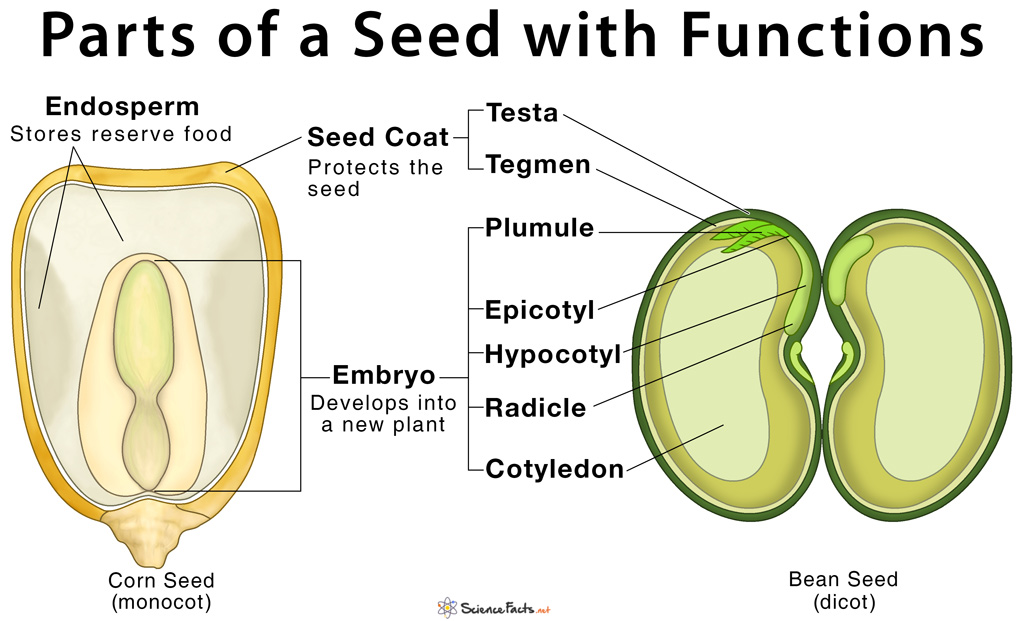3 Parts Of The Seed
A seed is a construction that encloses the embryo of a establish in a protective outer covering. Under favorable atmospheric condition of growth, a seed gives rising to a new plant, using the nutrients stored in them.
The union of the male and female reproductive cells within the ripened ovule of a bloom helps in the formation of seeds in a plant. Different seeds take unlike sizes, shapes, and colors that participate in the reproduction of flowering plants.
Parts and Structure of a Seed

A typical seed consists of three primary parts: 1) seed coat, 2) endosperm, and 3) embryo.
one) Seed Glaze
They are the protective outer covering of a seed that is usually hard, thick, and chocolate-brown in color. The seed glaze is formed from the outer roofing of the ovule chosen the integument. It unremarkably contains two layers: i) testa – the thick outer layer, and ii) tegmen – the fragile inner layer.
A seed coat has the following iv parts: a) Micropyle – the small opening present at one end of the seed coat, b) Funiculus – the seed stalk with which the seed is attached to the fruit body, the integument, c) Hilum – the region from which the seed breaks off from the fruit, leaving a scar, and d) Raphe – the base of the funiculus that is fused with the integument.
Functions
- Protecting the seed from physical and mechanical damage
- Preventing the seed from germination fifty-fifty under favorable weather condition of growth (seed dormancy)
- Preventing the excessive loss of h2o from the seeds
- Interim as a physical barrier against the entry of parasites
2) Endosperm
It is a tissue that is rich in oil, starch, and protein. Depending on the presence or absence of endosperm, seeds are of two types:
i) Non-endospermic or exalbuminous seeds – Characterized by the complete absence of the endosperm, such equally the seeds of the pea plant, groundnut, and gram.
ii) Endospermic or albuminous seeds – Characterized by the presence of the endosperm, such as the seeds of millets, palms, and lilies.
Functions
- Storing of reserve foods that provide nourishment to the developing plant
- Protecting the embryo, the side by side office of the seed, past acting as the mechanical barrier
three) Embryo
They are the young plant that is developing inside the seed coat. An embryo contains the underdeveloped tissues of leaves, stem, and roots of a plant.
What are the Parts of an Embryo of a Seed
- Epicotyl – The tiny shoot of an embryo, from which the entire shoot system develops. The tip of the epicotyl is called plumule.
- Hypocotyl – The stage of transition for the growing shoot and root of the embryo
- Radicle – The tiny root of the embryo
- Cotyledons – They are the leaves of the embryo that provide nourishment to the developing plant. There are ii types of cotyledons nowadays in flowering plants: i) monocotyledonous or monocots – embryo with i cotyledon and ii) dicotyledonous or dicots – embryo with ii cotyledons.
Functions
- Giving rise to a new complete new found
- Storing nutrient and nourishing the baby found
-
References
Article was concluding reviewed on Tuesday, October vi, 2020
3 Parts Of The Seed,
Source: https://www.sciencefacts.net/parts-of-a-seed.html
Posted by: goodnightmeaust.blogspot.com


0 Response to "3 Parts Of The Seed"
Post a Comment